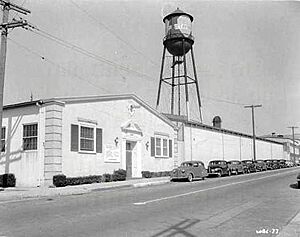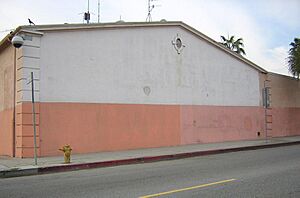Warner Bros. Cartoons facts for kids

Final logo, used from 1944 to 1948 and from 1953 to 1964
|
|
|
Formerly
|
Leon Schlesinger Productions (1933–1944) |
|---|---|
| Private | |
| Industry | Animation Motion pictures |
| Fate | Closed |
| Predecessor | Harman-Ising Productions |
| Successors | DePatie–Freleng Enterprises (1964–1980) Warner Bros.–Seven Arts Animation (1967–1969) Chuck Jones Enterprises (1970–2000) Warner Bros. Animation (1980–present) |
| Founded | June 1932 |
| Founder | Leon Schlesinger |
| Defunct | May 1963 |
| Headquarters | Los Angeles, California, U.S. (1932–1956) Burbank, California, U.S. (1956–1963) |
|
Key people
|
Leon Schlesinger, Edward Selzer, Friz Freleng, Chuck Jones, Mel Blanc, John W. Burton Sr., David H. DePatie, William L. Hendricks, Robert McKimson, Tex Avery, Bob Clampett, Arthur Davis, Frank Tashlin |
| Products | Animated theatrical short subjects Television shows |
| Parent | Warner Bros. (1944–1963) |
Warner Bros. Cartoons, Inc. was a famous American animation studio. It was the main animation team for Warner Bros. during a special time called the Golden Age of American animation. This studio created the super popular Looney Tunes and Merrie Melodies cartoon series.
Many of the characters from these cartoons, like Bugs Bunny, Daffy Duck, and Porky Pig, are known all over the world. The talented people who worked there, such as directors and animators like Chuck Jones, Friz Freleng, and Tex Avery, are seen as very important in the history of animation.
The studio started in 1933 as Leon Schlesinger Productions, named after its founder, Leon Schlesinger. Warner Bros. bought the studio in 1944 and changed its name to Warner Bros. Cartoons. The studio closed in 1963. Later, a new studio called Warner Bros. Animation took its place in 1980.
Contents
History of Warner Bros. Cartoons
Early Days: Harman-Ising Productions (1930–1933)
The Looney Tunes and Merrie Melodies cartoon series began in 1930 and 1931. They were created by Hugh Harman and Rudolf Ising for Leon Schlesinger. Warner Bros. Pictures helped release these cartoons in movie theaters.
The first Looney Tunes character was Bosko, The Talk-ink Kid. He was a cartoon star like Walt Disney's Mickey Mouse. In 1933, Harman and Ising left Schlesinger due to money disagreements. They took Bosko with them. To keep his contract with Warner Bros., Schlesinger started his own animation studio.
Leon Schlesinger Productions (1933–1944)
Schlesinger's new studio had a slow start. They continued making Merrie Melodies and introduced a new character, Buddy, for Looney Tunes. Buddy wasn't very popular.
In 1935, a director named Friz Freleng created the Merrie Melodies cartoon I Haven't Got a Hat. This cartoon introduced Porky Pig. Porky quickly became the studio's first big star. The studio also started using color for Merrie Melodies cartoons, first two-color and then full three-color Technicolor by 1935. Looney Tunes stayed in black-and-white until 1943.
The animators, including Tex Avery, Robert Clampett, and Chuck Jones, worked in a small building. They jokingly called it "Termite Terrace." This name later became famous for the entire Warner Bros. animation team.
From 1936 to 1944, many talented directors worked at the studio. They created some of the most famous cartoon characters ever. These include Daffy Duck (1937), Elmer Fudd (1940), Bugs Bunny (1940), and Tweety (1942).
By 1942, Schlesinger's studio was making more successful animated shorts than even Walt Disney Productions. During World War II, the studio also made cartoons for the United States military. These included the Private Snafu series, which entertained servicemen.
Warner Bros. Cartoons Takes Over (1944–1963)
On July 1, 1944, Leon Schlesinger sold his studio to Warner Bros. for $700,000. Warner Bros. renamed it Warner Bros. Cartoons, Inc. Edward Selzer became the new head of the studio.
After Schlesinger left, many new cartoon stars were created. These include Pepé Le Pew (1945), Sylvester (1945), Yosemite Sam (1945), Foghorn Leghorn (1946), Marvin the Martian (1948), Wile E. Coyote and the Road Runner (1949), Granny (1950), Speedy Gonzales (1953), and The Tasmanian Devil (1954).
In the late 1950s, budgets for cartoons became tighter. This was because of changes in how movies were sold to theaters. Directors like Chuck Jones had to work faster. Cartoon writers started focusing more on funny dialogue since there was less money for detailed animation.
In 1953, Warner Bros. temporarily closed its cartoon studio. They were worried that making cartoons for the new 3-D movies would be too expensive. The studio reopened five months later when the 3-D movie trend ended. In 1955, the team moved to a new building in Burbank.
In 1960, The Bugs Bunny Show started on ABC TV. This show featured old Warner Bros. cartoons with new parts to introduce them. It stayed on TV for many years, showing how popular these cartoons were.
David H. DePatie became the last leader of the original Warner Bros. Cartoons studio in 1961. In 1962, Chuck Jones left the studio. By late 1962, Warner Bros. decided to close the cartoon studio for good. This was because TV was becoming very popular, and fewer people were going to the movies. The studio officially closed in 1963.
Outsourced Cartoons (1964–1967)
After the studio closed, Warner Bros. hired other companies to make new Looney Tunes and Merrie Melodies cartoons. David H. DePatie and Friz Freleng started their own company, DePatie–Freleng Enterprises. They made many cartoons, mostly featuring Daffy Duck and Speedy Gonzales.
Another studio, Format Productions, was hired to make new Road Runner and Wile E. Coyote cartoons. However, many fans thought these new cartoons were not as good as the originals.
Warner Bros.-Seven Arts Animation (1967–1969)
| Fate | Closed |
|---|---|
| Predecessor | Warner Bros. Cartoons |
| Successor | Warner Bros. Animation |
| Founded | 1967 |
| Founder | William L. Hendricks |
| Defunct | October 10, 1969 |
|
Key people
|
Alex Lovy Robert McKimson Cal Howard Bob Kurtz William L. Hendricks Mel Blanc Larry Storch William Lava Hal Geer Don Douglas David Hanan Robert Givens Laverne Harding Lin Larsen Bob Abrams Bob Inman Bob McIntosh |
| Products | Cool Cat Speedy Gonzales Daffy Duck |
In 1967, Warner Bros. decided to bring cartoon production back in-house. They opened a new animation studio. Alex Lovy became the director. He brought in new animators, and the cartoons from this time looked different from the older ones.
The new studio made more Daffy and Speedy cartoons. They also created new characters like Cool Cat and Merlin the Magic Mouse. However, many fans did not like these cartoons very much.
After a year, Alex Lovy left. Robert McKimson returned to direct. He focused on the new characters. But on October 10, 1969, Warner Bros. stopped making all its short cartoons and closed the studio for good. Even after closing, the old Looney Tunes and Merrie Melodies cartoons remained very popular on TV for many years.
Key People at Warner Bros. Cartoons
Studio Heads
- Leon Schlesinger (1933–1944)
- Eddie Selzer (1944–1958)
- John Burton (1958–1961)
- David H. DePatie (1961–1963)
- William L. Hendricks (1967–1969)
Directors
- Tex Avery (1935–1942)
- Bob Clampett (1937–1946)
- Arthur Davis (1946–1949, 1962)
- Friz Freleng (1934–1965)
- Chuck Jones (1938–1964)
- Alex Lovy (1967–1968)
- Robert McKimson (1946–1969)
- Frank Tashlin (1936–1938, 1943–1946)
Storyboard Artists and Writers
- Warren Foster
- Friz Freleng
- Chuck Jones
- Michael Maltese
- Tedd Pierce
- Dr. Seuss
Animators
- Art Babbitt
- Bob Clampett
- Arthur Davis
- Friz Freleng
- Ken Harris
- Chuck Jones
- Robert McKimson
- Bill Melendez
- Virgil Ross
- Rod Scribner
Voices
- Mel Blanc (the voice of Bugs Bunny, Daffy Duck, Porky Pig, and many more!)
- Tex Avery
- Bea Benaderet
- Billy Bletcher
- June Foray
- Stan Freberg
- Arthur Q. Bryan (the voice of Elmer Fudd)
Music
- Carl W. Stalling (1936–1958)
- Milt Franklyn (1954–1962)
- William Lava (1962–1969)
Images for kids
See also
- The Golden Age of American animation
- Looney Tunes
- Merrie Melodies
- Warner Bros. Animation





